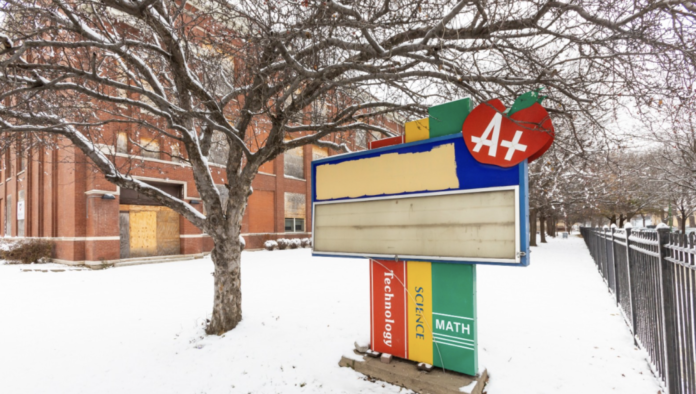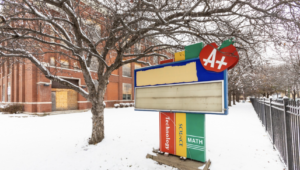

School closings are a political third rail in Chicago. Mayor Rahm Emanuel found out when he shut forty-nine of them in 2013. It was considerably fewer than the 330 schools, then narrowed to 129, that Chicago Public Schools (CPS) had identified as meeting under-enrollment criteria for closure. The schools were mainly on the South and West Sides, which have continued to lose population due to persistent deadly violence and other problems. The affected students were almost entirely Black.
A CPS school closure moratorium ensued from 2013 to 2018 but in 2020 the district revealed 253 of 500 schools eligible for analysis were under-enrolled, or less than seventy percent full. Many were much less full. The problem wasn’t going away.
So, what happened? A most Chicago-like thing.
When things aren’t going your way, rig the rules.
School Closure Moratorium
The state legislature was quickly persuaded to add a new school closure moratorium extending to 2025, to 2021 legislation for an all-elected Chicago school board, which was approved and signed into law.
This is how the Chicago and Illinois Democrats who control Springfield deal with the free market reality that families continue leaving CPS in droves.
Not by improving the schools and neighborhood safety dramatically, as required. But by making it illegal to close more of the emptying-out schools, and illegal to open more charter schools, to which families had been flocking.
Having angered the Chicago Teachers Union (CTU) and the race-baiting activist class with his 2013 school closings, Emanuel in 2016 was struggling to negotiate a new contract with the union and fearing another strike like the one which lasted seven days in 2012.
Spooked by a one-day strike during these new contract talks, he caved on charter schools and agreed to the union’s insistence on a charter school growth cap. The teachers union had found Rahmbo’s weak spot, and broken him. That charter schools had been an oasis in the CPS enrollment desert didn’t matter.
Charter schools should never be considered an infallible, must-choose option. But many families see the inherent possibilities and promise in charter schools because their management, daily practices and priorities are set based on the best interests of children rather than those of the power-mad CTU.
CTU Strangling The Growth Of School Choice In Chicago
So it is wrong – deeply wrong – to limit the future growth of charter schools in Chicago.
Blithely, CPS thinks things are mostly hunky-dory. In 2019 CPS gave 78 percent or 499 of its 638 schools a “good-standing grade” of some sort while 22 percent or 138 were not in good standing. The state school report card analysis for Chicago in 2019 was that 70 percent or 446 CPS schools were doing well or reasonably well, and 30 percent or 192 were not. CPS and Chicago Mayor Lori Lightfoot have also trumpeted record-high 82 percent high-school graduation rates.
That’s all a shell game.
The SATs painted a picture of Chicago’s public schools far less sanguine than the district’s self-rating scheme or a graduation rate jimmied through relaxed standards.
A perfect SAT score is 1600; 800 each on math and English. The University of Illinois SAT middle range for freshmen entering in Fall, 2020 was a combined math and English score of 1290 to 1490. The Illinois School Report Card sets the “grade-level” standard much lower; at 540 in math and 540 in English, or 1080 combined.
So there’s that backdrop.
Now for the shock – or not – to the system.
In 2019 only 26 percent of CPS 11th graders earned a 540 or better SAT score in English, and just 27 percent a 540 or higher in math. For Black CPS 11th graders, 14 percent met that low state standard in English and 13 in math.
Education Is A Lifesaver. Like, Literally
Yet these kids want to get somewhere better, an aspiration that in Chicago’s brutally violent neighborhoods all too often has life-or-death implications.
In a 2013 student survey three-quarters of CPS high school students said they wanted to earn a four-year college degree. But for CPS high-schoolers entering ninth grade in 2019, based on recent past outcomes, a University of Chicago education research arm projected that within ten years only 20 percent would earn four-year degrees and another 7 percent a two-year degree. For black male students ten years after entering ninth grade in 2019, U of C researchers found that only 12 percent were likely to get a post-secondary degree.
By Fall of 2019 charters schooled nearly 16 percent of Chicago’s public school students. But growth had ceased due to the charter school enrollment cap.
The limit was renewed in the 2019 contract deal between CTU and CPS under Mayor Lightfoot. By the end of the contract in 2024 there could be no more than 101 percent of 2018 charter school enrollment at CPS, and no net growth in the number of charter schools.
But a fifty-state study published in 2021 by the University of Arkansas School Choice Demonstration Project found that states offering a wide array of school choice – including public charters, private school vouchers, and tax-credit scholarships for private schooling – were “significantly associated” with higher eighth-grade math and reading scores in 2019 and greater gains from 2003 to 2019 in the National Assessment of Educational Progress (NAEP), known as “the nation’s report card.” The study’s analyses controlled for a wide range of influences on scores, and school choice still came out on top.
Risk Management, Open Doors At Chicago’s Catholic Schools
During Covid’s first brutal year for Chicago schools, parents became even more interested in alternatives to union-run schools. Through the autumn of 2020 and again from early 2021 on, Chicago’s Catholic schools were open for on-site learning with abundant precautions while at CPS, remote-only education ordered in 2020 was kept in place several more months into the new year.
This despite a Centers for Disease Control January 2021 report recommending the reopening of public schools with masking and distancing protocols. The CDC said it was especially important to capture the “health and social benefits” of in-person schooling, “especially for children and parents of lower socio-economic status.”
To be clear, many charter schools in Chicago went remote-only during Covid too, but they have more autonomy. Decisions are made by the charter school operator, which may run, say, a dozen schools, or one or three schools, rather than 600-plus.
Contrary to the disinformation unhesitatingly swallowed by gullible, closed-minded “progressives,” charter schools are public schools.
A charter is a document spelling out how the school is to be run and its goals. Parents have to be involved. Teachers often work longer hours. The school day and school year may be longer. Public charter schools tend not to be unionized. In big cities they focus almost exclusively on students of color.
CPS reviews charter school applications in the city and allows or denies them. The only exception: eight of Chicago’s 122 charter schools were authorized by the state. CPS can exercise its power to close under-enrolled or underperforming schools of any type including charter schools. It has done so.
Rigged Rules Are Pervasive
Rigged rules are pervasive in Chicago and Illinois. Outrageous demands of the unions such as capping seats at fast-growing charter schools, are made possible by overly liberal strike provisions in negotiated and legislated CTU bargaining rights. Chicago teachers went on strike for seven days in 2012, one day in 2016, and eleven school days in 2019. The possibility of a strike lasting weeks or months is dreaded by politicians, administrators, and parents.
Technically the CTU right to strike is limited to pay, benefits, and then in 2021, also new issues okayed by the state legislature including schedules, remote learning, and child-care allowances.
But the right to strike on certain issues provides leverage on others. In 2012 Emanuel dropped a teacher merit pay contract provision. In 2016 and 2019 the charter growth cap was enacted and then renewed, as CTU struck during contract talks.
Instead of tilting negotiating power to the teachers union with broadly-defined rights to strike, there could instead be a stipulation of mediation, or failing that, arbitration, if contract talks badly stall. With a right to strike, the game is always rigged for the union.
Rigging rules to restrain growing competition in public education in Chicago is no mere conservative cavil when a large majority of Black and Latino students are consistently failing to emerge from 12th grade equipped either for college or trades which often too require solid math and reading skills.
Chicago Public Schools are a rolling tragedy in public policy. That the school board will now transition from mayorally-appointed to all-elected would in some other cities be a good thing. In Chicago it means only that the CTU’s muscular political arm will surely wring fealty from school bosses to their ruinous priorities.